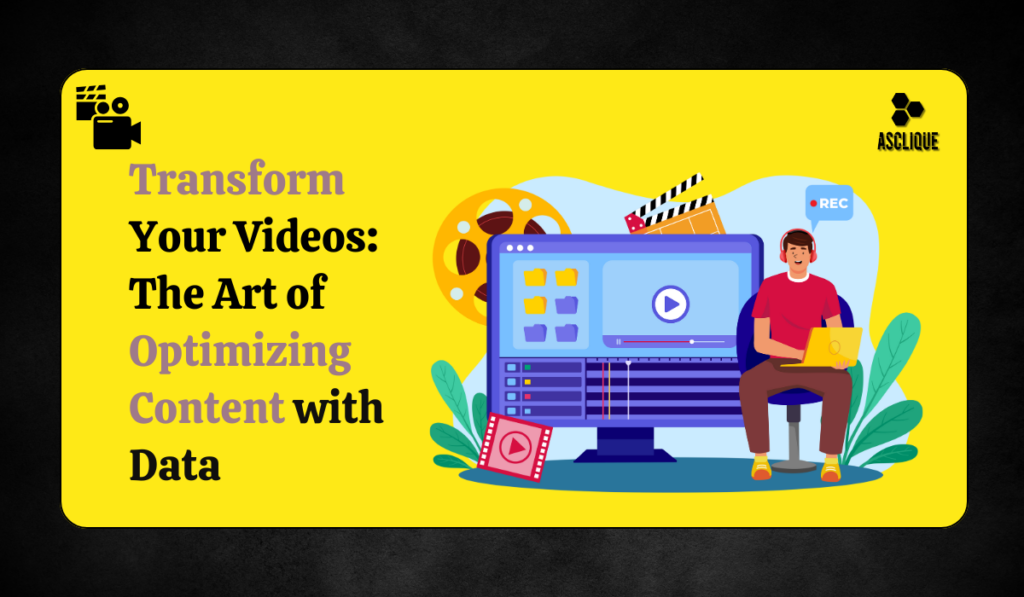In today’s busy digital world, video content is among the most powerful ways to engage your audience and drive business results and optimizing video content based on data is very useful in it. But producing a video is not sufficient. To ensure that it realizes its full potential, you need to focus on data-driven video content optimization. By measuring key performance indicators, you can refine your content, increase engagement, and ultimately create more return on investment (ROI). That’s how you can leverage data to refine your video strategy and achieve better results.
Why Data-Driven Optimization Matters
Video content is a dynamic medium that keeps changing, and its performance is also dynamic. Without data, it is hard to tell whether your video strategy is connecting with the target. Data-driven video optimization allows you to customize your content based on real feedback from your audience. With insights into how your users interact with your videos, such as watch time, engagement, and conversion rate, you will be able to make data-driven decisions resulting in improved performance and ROI. Data more or less eliminates video marketing guesswork by letting you create videos that actually resonate with your audience.
Key Performance Indicators to Monitor for Effective Video Optimization
For effective optimizing video content based on data, you need to consider several key performance indicators (KPIs). These will help you understand how your videos are doing and where they need improvement. Some of the most significant metrics to track are:
Watch Time:
This is the duration that viewers watch your video. The greater the watch time, the more it reflects that your content is engaging and interesting.
Engagement Rate:
This comprises likes, comments, shares, and other engagement. The more engaging the rate of engagement, the more it reflects that your video is engaging users and encouraging discussion.
Click-Through Rate (CTR):
This measures how often viewers are clicking on links or CTAs within your video. If you have a high CTR, it tells you that your video is performing wonderfully at encouraging users to take action.
Drop-Off Rate:
This tells you where your viewers are falling off your video. High drop-off in the first half of your video tells you that you need to improve the beginning or recreate your video length.
Conversion Rate:
The viewers who take action on your intended action after viewing your video, i.e., buying or subscribing to a newsletter. It’s one of the best ROI metrics. By looking at these metrics, you can make decisions that have a direct impact on your video performance.
Customizing Video Content to Encourage Engagement
One of the best methods for growing engagement is personalization. Using data to optimize video content enables you to customize your videos for particular segments of an audience. Once you know what works with various groups (demographics, geolocation, watch behavior, etc.), you can produce more compelling and pertinent content.
For example, if your statistics tell you that younger viewers prefer watching short, quick-paced videos, you can tailor your content to their preference. Or if you find out that a specific geographic area is more open to certain topics, you can make videos to talk about topics attractive to regions. Data-driven personalization makes your videos interesting, leading to increased engagement and higher conversion chances.
A/B Testing for Continuous Improvement
A/B testing is a powerful form of data-driven optimization of video content. It allows you to compare multiple variations of a video to see which one performs best. This might be comparing different titles, thumbnails, video lengths, or CTAs. You might compare a short teaser video and a long explainer video to see which one retains viewers longer. Or, compare different CTAs to see which one is clicked the most and leads to the most conversions.
With all your video content continuously being tried out with A/B testing, you can recognize what works the best with viewers and experiment in order to yield the best performing video, engaging more and obtaining better ROI.
SEO for Video: Gaining Visibility Based on Data

SEO isn’t just for use on blog pages and websites—optimizing video content based on data also translates to using SEO strategies to attain maximum visibility. To get the most out of your video content, ensure it is easily discoverable on channels like YouTube, Google, and Vimeo. Start by conducting keyword research to find relevant terms your target audience is searching for. Include these keywords in your video title, description, and tags. Data from tools like YouTube Analytics, and Google Trends, will be able to inform you what trending topics and best-placed keywords are, and therefore make your video discoverable.
Aside from keyword optimization, make sure that you also have a hooky thumbnail, proper descriptions, and proper metadata. Optimizing video SEO with data makes your content searchable, hence exposing your content and opening up more opportunities for engagement.
Maximizing Your Video for Maximum ROI
The ultimate goal of each video marketing effort is to create a good return on investment. Data-optimized video content helps you do so because it helps you track performance against business objectives. For example, if you’re attempting to generate leads through your videos, track the viewers who click on your landing pages. If you want brand awareness, track how many times your video is being discussed and shared on social media.
For example, if you need to generate leads from your videos, track how many clicks are going to your landing pages. If you need to generate brand awareness, track how many times your video is shared or discussed on social media.
By analyzing data, you can understand what videos are generating the most value and optimize underperforming videos. This enables you to better allocate resources, create more effective videos, and ultimately drive more ROI.
Also Read : Do Short-Form Videos Really Convert Users? The Truth Revealed!
The Power of Continuous Optimization
It is a process and not an event; it is a recurring practice rather than something that is done once. With each time you monitor more performance metrics, make the content specific, and run A/B tests, you’ll be gaining more that you can apply in terms of informing future decisions. With the constant optimizing of your video strategy according to these data, you can make each subsequent video better than the last.
Data is a fuel for continuous improvement. By regularly checking your performance indicators and adjusting your strategy, you can ensure that your video content remains effective and relevant, producing long-term engagement and ROI.
Conclusion
The optimizing video content based on data with the competitive nature of the online world today, data-driven video optimization is a must to achieve higher engagement and optimize ROI. By tracking important metrics, content personalization, A/B testing, and SEO optimization, you can create videos that not only capture attention but also deliver measurable outcomes. Data informs you about what works and what doesn’t, thus, allowing you to optimize your video strategy as the tastes and behaviors of your audience evolve. Lastly, data-driven video optimization allows you to make informed decisions, enhance video performance, and achieve more success with your video marketing efforts.
FAQs
How can A/B testing improve video content?
A/B testing identifies the best versions of a video through the comparison of two or more versions. For instance, a comparison of different titles, thumbnails, or video lengths may indicate which of these elements a viewer is more likely to view. Viewer-driven optimization of video content through data leads to increased engagement and ROI.
Will SEO optimize video content with the use of data?
Yes, search engine optimization is key to visibility of your video content. You can see what your audience is searching for with keyword research data and optimize your video title, description, and tags. SEO gets maximum exposure on YouTube and Google and leads to more views, engagement, and ultimately performance.
How do I customize video content from information?
Personalization is the process of creating video content based on your audience’s interests. Through data analysis, you can identify the category of people, activities, and interests that are most interested in your videos. Based on this information, you can create content that targets specific groups of audiences, thus making your videos more appealing and relevant.
How do I calculate ROI for video marketing campaigns?
ROI measurement is all about connecting video performance metrics (e.g., engagement, conversions, sales) to your business goals. Utilize data to measure how many leads, sales, or sign-ups your videos are generating. If your video is not generating the desired result, you can optimize your strategy based on the data insights .
What is the role of data in continuous video optimization?
For optimizing video content based on data, data is critical to continuous video optimization because it provides you with continuous feedback on how your videos are performing. By tracking metrics such as engagement, watch time, and conversion rates on a regular basis, you can adjust your videos.

